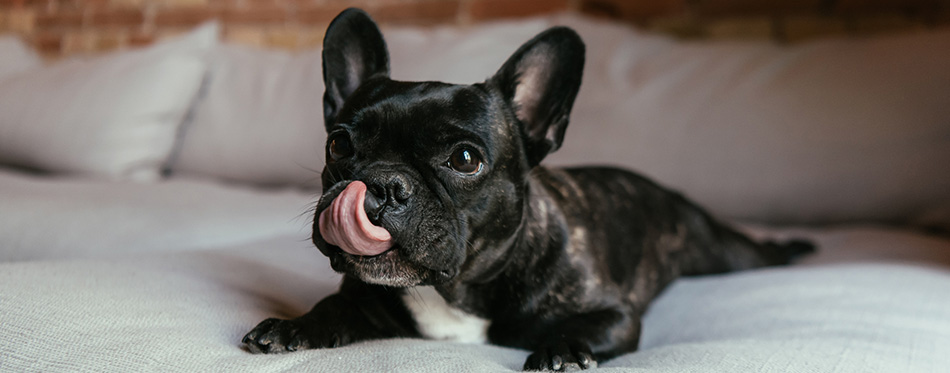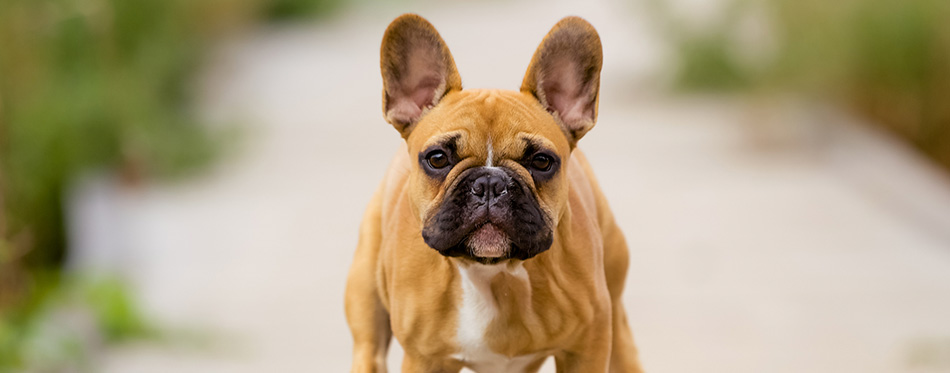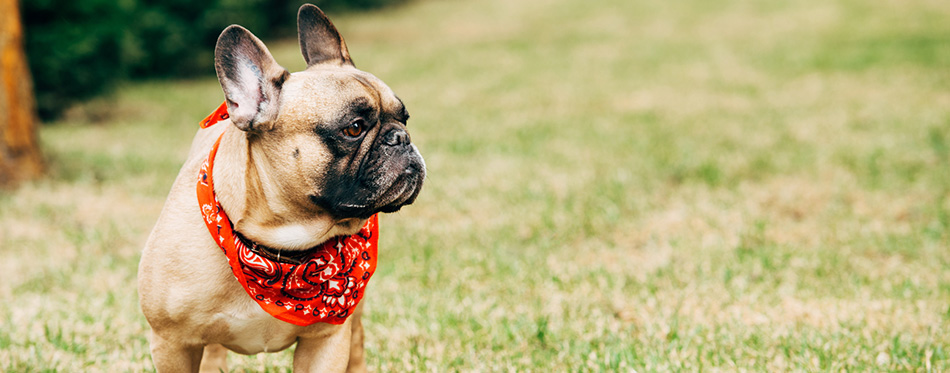The Frenchie, as people call the French Bulldog, is an adorable hound that has distinctive bat ears. It looks tough on the outside, but inside its small frame is a sweet and delightful personality. This is a dog that is best for certified couch potatoes as well as those who live without the luxury of a spacious suburban backyard. Like all canine breeds, however, the French Bulldog requires a lot of love and care from its owner.

History of the French Bulldog
The French Bulldog did not originate in France. Its origins are traceable to ancient Molossian dogs. These are large and very powerful canines capable of fighting large ferocious beasts. As Phoenician traders explored the rest of the ancient world, some of them brought their Molossers to the British Isles. Here, the foreign Molossers mated with local dogs to produce the Bullenbeisser, a sub-breed of the English Mastiff.
The Bullenbeisser was a remarkable canine when it came to the bull ring. The British loved to watch bull-baiting activities whereby the Bullenbeisser and other “bull dogs” showcased their sheer strength and courage.
By 1835, England had already begun outlawing bull-baiting and other animal blood sports. Some of the famed bull dogs became unemployed. Some were fortunate enough to become the companion animals of English families. To make them more suitable as companion dogs, bull dog owners mated them with small terriers to produce the Toy Bulldog in 1850.
The Industrial Revolution displaced many lace workers from Nottingham at around the same time. Many of them brought their Toy Bulldogs as well as other dogs as they settled across the English Channel in Normandy, France. The French became fascinated with these small dogs, starting the dog trade.
English breeders sent to France bulldogs that they deemed were too small or have faults such as bat-like ears. French specialist dog exporters strived to grow the popularity of the small breed. The English Toy Bulldogs became the favorite of many French society ladies as well as Parisian prostitutes. Those in the creative arts like painters, fashion designers, writers, and artists also favored the small dog. Because of this, they began considering the canine as a distinct breed. It gave birth to the name “Bouledogue Francais”.
Unfortunately, the French did not keep records or documents that tracked the dog’s development. Over time, the French Bulldog has grown more divergent from its English roots. Fanciers believe that the French introduced terriers into the breed to give the Frenchie its characteristic long, straight, and standing up ears.
Some of these French Bulldogs found their way to American shores. By 1885, American breeders decided to set up a breeding program that is more in-tune with their “tastes”. Society ladies were the first to showcase the breed at the 1896 Westminster Kennel Club Dog Show in New York City. Unfortunately, show judges favored dogs with the rose type of ears, not the bat type.
This motivated the ladies to form the French Bull Dog Club of America. They also started working on the standards of the breed with emphasis on the erect “bat-like” ears as the true standard of the French Bulldog.
Frenchies were in vogue for America’s high society. Historians say a Frenchie can cost up to $3,000 at the time. Today, this is the equivalent of $86,681. Not long after, the breed gained its formal recognition from the American Kennel Club. By 1906, the Frenchie is already America’s fifth most popular dog breed. Through the AKC’s existence, the breed has always been in the top 10. In 2018, it reached fourth place, bested only by the trio of the Labrador, German Shepherd, and Golden Retriever.
Quick Facts about the French Bulldog
Frenchies are adorable creatures; no doubt about that. But before you start contemplating on getting a French Bulldog in your home, consider these facts first.
It is a Small Dog
The Frenchie is a small canine, reaching a maximum height of 13 inches and weighing less than 28 pounds. It retains the stocky build of its English ancestors, including a loose coat that forms wrinkles. The Frenchie’s small size makes it a great companion dog. While you cannot fit it in your purse like a Chihuahua or a Yorkie, it does make a wonderful pet trotting along.
Frenchies are the Favorites of Superstars
Following the popularity of its forebears in France, the modern-day French Bulldog also has a lot of admirers from America’s high society. Hugh Jackman, Dwayne “the Rock” Johnson, and Leonardo DiCaprio all own a Frenchie. So do Yves Saint Laurent, Nancy Mitford, and D. H. Lawrence. David and Victoria Beckham have a Frenchie, too. Another celebrity who owns a French Bulldog is Lady Gaga. Martha Stewart also created a blog for her own Frenchies.
The Breed Cannot Swim
Frenchies have a bulbous head where it is very difficult to distinguish its neck from the rest of its body. If ever it gets in the water, it will not be able to stick its head high enough above the water line. Plus, it has a snub nose that lies flat against its face. It does not stick out, allowing water to enter through its nostrils. The French Bulldog also has a squat frame and short, stubby legs. This can make paddling in the water very difficult for the dog. Besides, it tires very fast.
It is for this reason that pet parents should always be very careful whenever they head to the beach with their Frenchies. The same is true for pet parents who have swimming pools at home. Supervise the French Bulldog whenever it is playing around bodies of water.
They Cannot Travel by Plane, Either
Well, they can. However, many airline companies do not allow French Bulldogs on any of their flights. There have been incidents wherein the dog perished during the flight. The reason is the physical attributes of the breed. It is brachycephalic, meaning it has a very short snout. This can make breathing very difficult. When combined with the stress of flying, it can lead to a host of breathing problems for the dog.
There are airline companies that understand the need of pet parents to travel with their Frenchie and other brachycephalic breeds. These companies provide a special space for pets with special needs. A trained professional is on hand to provide assistance to these pets during the flight.
Artificial Insemination is the Name of the Game
While there are Frenchies that can reproduce in the natural way, most will require the assistance of their owners. Many of these dogs have difficulty copulating because of their unusual proportions. In addition to getting tired and overheating very quickly, males can also have a hard time trying to reach the females. They can get exhausted in a very short period of time.
Artificial insemination addresses such issues. The problem is that it also jacks up the price. On a positive note, artificial insemination allows breeders to check for potential problems before proceeding with the insemination.
Giving birth can also be a problem for the Frenchie. In more than 80 percent of French Bulldog puppies, they are delivered via Caesarian section. It is the only way for them to give birth in a safer and less stressful manner.

Things You Should Know
Becoming the pet parent of a French Bulldog should be easy enough. However, there are a few things that all wannabe Frenchie parents have to know.
Health
French Bulldogs are not the healthiest breeds owing to their brachycephalic nature. Some will live up to 13 years, although most will live only up to 11. In the UK, the average life expectancy of Frenchies is between 8 and 10 years. The AKC says the breed can live anywhere between 11 and 13 years.
The brachycephalic nature of the breed combined with its short single coat can pose a host of problems. First, it is unable to regulate its temperature in an efficient manner. It is very prone to heat stroke and hypothermia. It is also susceptible to patellar subluxation whereby the knee cap is not in its normal anatomical position.
Other health problems can include back and spine diseases such as chondrodysplasia and congenital hemivertebrae. The breed can also suffer from glaucoma, corneal ulcers, retinal fold dysplasia, and juvenile cataracts.
Feeding
Feeding the French Bulldog is never a problem. Giving it high-quality dog food with a complete and well-balanced set of nutrients is the way to go. Most pet parents give their Frenchies kibbles. You can also do that, provided you choose well. Many of the products on the market come with unnecessary fillers that can be difficult to digest.
Canned dog food is quite expensive, but it provides exceptional levels of proteins for your pet. It also contains more moisture, which mimics the moisture content of raw whole prey foods. The best food for Frenchies is raw. However, not all pet parents are confident enough to adhere to the principles of raw feeding dogs.
Pay attention to the number of calories that you give to the Frenchie. This is a dog that is not immune to being obese. Remember that it is not an active dog. It can transform any excess calorie into fat. French Bulldogs already have problems breathing because of their brachycephalic nature. Adding to its weight can further complicate breathing difficulties.
Care
All French Bulldogs need regular veterinary visits for their routine health screening and mandatory vaccinations. There are several tests that can help identify certain disease risk factors in the French Bulldog. This will help in the prevention of such diseases.
Frenchies do not require long walks. Fifteen minutes of casual walk every day should be enough. They will also need at least 15 minutes of play time to help further strengthen your bond with the dog. This also helps eliminate canine boredom, another reason why behavioral problems can occur.
Due to their tendency to overheat, French Bulldogs should always stay in an airconditioned room. Pet parents should also take measures to prevent overheating and heat stroke. In cold places, it is crucial for the Frenchie to keep warm.
Grooming
Brushing the dog’s coat is a must, although you can do this on a weekly basis instead of the usual everyday routine. Bathing can also be done once a month or as needed. This will help maintain the cleanliness of its coat while aiding in the health of its skin. French Bulldogs can also shed their coat, but only twice a year. You can assist the pet during this time by combing or brushing its coat every day.
Trimming the nails, cleaning the ears, and brushing the teeth are all routine grooming activities. What you need to include is caring for its wrinkled skin. One should clean the deep skin folds every day using a soft, damp cloth. It is important to dry the skin folds well to help prevent the growth of bacteria.

Temperament
Being a companion dog, the French Bulldog needs to be in close contact with its owner. If not, the dog can become anxious, a condition we know as separation anxiety. Separation anxiety can lead to many behavioral problems in the breed.
Other than that, the French Bulldog is an alert, adaptable, and playful breed. It has an even disposition and a level of friendliness that it shares with very few other breeds. It greets anyone who enters the door. It will be on the prowl to see who among the guests will be kind enough to take the dog in his or her lap.
Frenchies are like Velcros. They will follow their master around the house. The good news is that they will never be a nuisance. In case they want your attention, they will give you a gentle tap on your leg. Unlike other small breeds, the Frenchie is not very vocal. As such, in the rare instances when it does bark, you should pay attention as it often means something.
Without a doubt, the French Bulldog is an adorable breed. And if you want to be on the growing list of happy Frenchie owners, then you should take note of these bits of information we provided.

